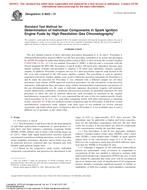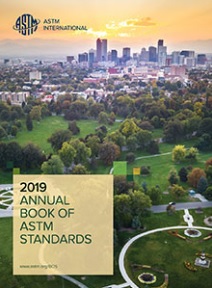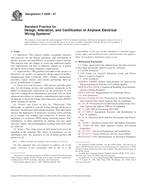
ASTM D6623-01
1.1 Procedures A and B:
1.1.1 Test Procedures A and B provide for the determination of individual hydrocarbon components of spark-ignition engine fuels and their mixtures containing oxygenate blends (MTBE, ETBE, ethanol, and so forth.) with boiling ranges up to 225oC. Other light liquid hydrocarbon mixtures typically encountered in petroleum refining operations, such as, blending stocks (naphthas, reformates, alkylates, and so forth.) may also be analyzed; however, statistical data was obtained only with blended spark-ignition engine fuels.
1.1.2 Based on the cooperative study results, individual component concentrations and precision are determined in the range of 0.01 to approximately 30 % mass percent. The procedures may be applicable to higher and lower concentrations for the individual components; however, the user shall verify the accuracy if the procedures are used for components with concentrations outside the specified ranges.
1.1.3 Test Procedures A and B also determine methanol, ethanol, t-butanol methyl t-butyl ether (MTBE), ethyl t-butyl ether (ETBE), t-amyl-methyl-ether (TAME) in spark ignition engine fuels in the concentration range of 1 to 30 mass %. However, the cooperative study data provided sufficient statistical data for MTBE in Procedure B only.
1.1.4 Although a majority of the individual hydrocarbons present are determined, some co-elution of compounds is encountered. If this test method is utilized to estimate bulk hydrocarbon group-type composition (PONA) the user of such data should be cautioned that some error will be encountered due to co-elution and a lack of identification of all components present. Samples containing significant amounts of olefinic or naphthenic, or both (for example, virgin naphthas) constituents above N-octane may reflect significant errors in PONA type groupings. Based on the gasoline samples in the interlaboratory cooperative study, these procedures are applicable to concentrations of olefins to less than 25 mass %. However, some interfering coelution with the olefins above C7 is possible, particularly if blending components or their higher boiling cuts such as those derived from fluid catalytic cracking (FCC) are analyzed, and the total olefin content may not be accurate. Appendix X1of this test method compares results of the test procedures with other test methods for selected components, including olefins, and several group types for several interlaboratory cooperative study samples. Although benzene, toluene and several oxygenates are determined, when doubtful as to the analytical results of these components, confirmatory analysis can be obtained by using the specific test methods listed in the reference section.
Total olefins in the samples may be obtained or confirmed, or both, if necessary, by Test Method D1319 (volume %) or other test methods, such as those based on multidimentional PONA type of instruments.
1.1.5 If water is or is suspected of being present, its concentration may be determined, if desired, by the use of Test Method D1744 or equivalent. Other compounds containing oxygen, sulfur, nitrogen, and so forth may also be present, and may co-elute with the hydrocarbons. If determination of these specific compounds is required, it is recommended that test methods for these specific materials be used, such as Test Methods D4815 and D5599 for oxygenates, and Test Method D5623 for sulfur compounds or equivalent.
1.2 Procedure C
1.2.1 Test Procedure C provides for the determination of individual hydrocarbon components of spark-ignition engine fuels with boiling ranges up to 225oC. Other light liquid hydrocarbon mixtures typically encountered in petroleum refining operations, such as, blending stocks (naphthas, reformates, alkylates, and so forth) may also be analyzed; however, statistical data was obtained only with blended spark-ignition engine fuels. The tables related to Procedure C enumerate the components reported. Component concentrations are determined in the range of 0.10 to 15 mass %. The procedure may be applicable to higher and lower concentrations for the individual components; however, the user shall verify the accuracy if the procedures are used for components with concentrations outside the specified ranges.
1.2.2 This test method is applicable also to spark-ignition engine fuel blends containing oxygenated components. However, in this case, the oxygenate content shall be determined by Test Methods D5599 or D4815.
1.2.3 Benzene co-elutes with 1-methylcyclopentene. Benzene content shall be determined by Test Method D3606 or D5580.
1.2.4 Toluene co-elutes with 2,3,3-trimethylpentane. Toluene content shall be determined by Test Method D3606 or D5580.
1.2.5 Although a majority of the individual hydrocarbons present are determined, some co-elution of compounds is encountered. If this procedure is utilized to estimate bulk hydrocarbon group-type composition (PONA) the user of such data should be cautioned that some error will be encountered due to co-elution and a lack of identification of all components present. Samples containing significant amounts of olefinic (for example, cracked naphthas) or naphthenic, or both (for example, virgin naphthas) constituents above N-octane may reflect significant errors in PONA type groupings. Based on the interlaboratory cooperative study, this procedure is applicable to concentrations of olefins to less than 20 mass %. However, some interfering coelution with the olefins above normal heptane is possible, particularly if blending components or their higher boiling cuts such as those derived from fluid catalytic cracking (FCC) are analyzed, and the total olefin content may not be accurate. Since many of the olefins in spark ignition fuels are at a concentration below 0.10 %, they are not reported by this test method and may bias the total olefin results low.
Total olefins in the samples may be obtained or confirmed, or both by Test Method D1319 (volume %) or other test methods, such as those based on multidimentional PONA type of instruments.
1.2.6 If water is or is suspected of being present, its concentration may be determined, if desired, by the use of Test Method D1744. Other compounds containing sulfur, nitrogen, and so forth may also be present, and may co-elute with the hydrocarbons. If determination of these specific compounds is required it is recommended that test methods for these specific materials be used, such as Test Method D5623 for sulfur compounds.
1.3 The values stated in SI units are to be regarded as the standard. The values given in parentheses are provided for information only.
1.4 This standard does not purport to address all of the safety concerns, if any, associated with its use. It is the responsibility of the user of this standard to establish appropriate safety and health practices and determine the applicability of regulatory limitations prior to use.
Product Details
- Published:
- 03/10/2001
- Number of Pages:
- 109
- File Size:
- 1 file , 3.1 MB

